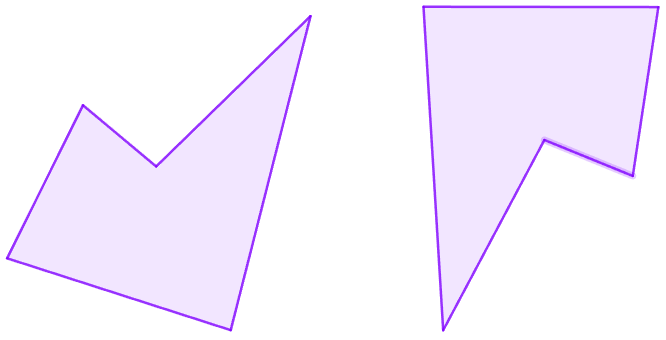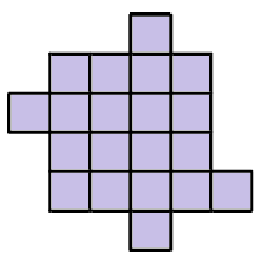Problems
In a bag we have \(99\) red balls and \(99\) blue balls. We take balls from the bag, two balls at a time:
If the two balls are of the same colour, then we put in a red ball to the bag.
If the two balls are of different colour, we return a blue ball to the bag.
Regardless, after each step, one ball is lost from the bag, so eventually there will be only one ball. What is the colour of this last ball?
Today we will learn a really useful strategy for solving a certain kind of problems. This strategy is called the invariance principle, and after working through this sheet you’ll be able to recognise easily when we need to use an invariant to solve a problem. This strategy is applicable to kinds of problems where some task is repeatedly performed, and we wish to see if it is possible to transform our “initial state" into some given “final state". We will see by solving these problems, that sometimes we can identify a property of our setup that never changes after this repeated task is performed. Such a property is called an invariant. Sometimes however, we can identify a property that does change, but always changes in the same way. These are called monovariants (the prefix “mono" comes from Greek, meaning “one", i.e: monovariants are quantities that change in one particular way). Let’s check out some examples to see these concepts in practice.
You have an \(8\times 8\) chessboard coloured in the usual way. You can pick any two adjacent squares (i.e: any \(2\times 1\) or \(1\times 2\) section of the board) and flip the white tiles to black tiles and vice-versa. Is it possible to finish with \(63\) white pieces and \(1\) black piece?
The topic of this problem sheet will be polynomials. Before we dive into the examples, let’s recap a few key concepts.
A polynomial in \(x\) is an expression formed by adding or subtracting monomials, which are terms of the form \(a x^n\), where \(a\) is a number called a coefficient, and \(n\) is a whole number (non-negative integer). Here, \(x\) is a variable that may represent a number. The degree of a polynomial \(f\), written as \(\deg(f)\) is the highest power of \(x\) appearing in the polynomial. For example: \(\deg(x^3+x^2+x)=3\). Thus, we write the general form of a polynomial of degree \(n\) as
\[p(x)=a_nx^n+a_{n-1}x^{n-1}+\cdots + a_1x+a_0,\] where \(a_n\) must be non-zero (otherwise the degree would be \(n-1\)). We can perform several familiar operations on polynomials, which you may have seen before:
Addition and subtraction: We add or subtract polynomials by looking at each power of \(x\) and adding or subtracting the corresponding coefficients. Generally: \[(a_nx^n+a_{n-1}x^{n-1}+\cdots + a_1+a_0)+(b_nx^n+b_{n-1}x^{n-1}+\cdots + b_1+b_0)=(a_n+b_n)x^n + (a_{n-1}+b_{n-1})x^{n-1}+\cdots + (a_1+b_1)x+(a_0+b_0).\]
For example, if \[f(x) = x^4 + 3x - 1 \quad \text{and} \quad g(x) = x^3 + 2x + 5,\] then \(f(x) - g(x) = x^4 - x^3 + x - 6\).
Multiplication: We use the distributive property, which means that every term in the first polynomial is multiplied by every term in the second polynomial. Generally:
\[(a_nx^n+\cdots a_1x+a_0)(b_mx^m +\cdots + b_1 x + b_0) = a_nb_m x^{n+m}+\cdots + a_ib_j x^{i+j}+\cdots + a_0b_0,\] where \(1\leq i \leq n\) and \(1\leq j \leq m\). For example, if \[f(x) = x^2 + x + 1 \quad \text{and} \quad g(x) = x - 1,\] then \(f(x) g(x) = (x^2 + x + 1)(x - 1) = x^3 + x^2 + x - x^2 - x - 1 = x^3 - 1.\)
Let’s now present the examples. They have some very important techniques, so read them carefully before attempting the problems.
In this example we will discuss division with remainder. For polynomials \(f(x)\) and \(g(x)\) non-zero with \(\deg(f)\geq \deg(g)\) there always exists polynomials \(q(x)\) and \(r(x)\) such that \[f(x)=q(x)g(x)+r(x)\] and \(\deg(r)<\deg(g)\) or \(r(x)=0\). This should look very much like usual division of numbers, and just like in that case, we call \(f(x)\) the dividend, \(g(x)\) the divisor, \(q(x)\) the quotient, and \(r(x)\) the remainder. If \(r(x)=0\), we say that \(g(x)\) divides \(f(x)\), and we may write \(g(x)\mid f(x)\). Let \(f(x)=x^7-1\) and \(g(x)=x^3+x+1\). Is \(f(x)\) divisible by \(g(x)\)?
We start with the point \((1,3)\) of the plane. We generate a sequence of points with the following rule: the \(x\)-coordinate of the new point is the arithmetic mean of the \(x\) and \(y\) coordinates of the previous point, and the \(y\)-coordinate of the new point is the harmonic mean of the \(x\) and \(y\) coordinates of the previous points. The harmonic mean of two numbers \(x\) and \(y\) is \(\frac{2}{\frac{1}{x} + \frac{1}{y}}\). Is the point \((3,2)\) in the sequence?
Four black dots are drawn on a whiteboard. On the dots we write the numbers \(10\), \(20\), \(30\), and \(40\) (one number on each dot). We then repeat the following move any number of times: choose one dot, decrease its number by \(3\), and increase the number on each of the other three dots by \(1\). After some number of moves, is it possible for all four dots to show the number \(25\) simultaneously?
Every year the citizens of the planet “Lotsofteeth" enter a contest
to see who has the most teeth.
This year the judge notices:
Nobody has 0 teeth (everyone has at least 1).
There are more people in the contest than the most teeth that any one person has. (For example, if the most teeth anyone has is 27, then there are more than 27 people participating in the contest.)
Must there be two people who have exactly the same number of teeth? Explain why.
Fred and George each had a square cake. Both of them made two straight cuts across their cake, from edge to edge. How could it happen that Fred ended up with three pieces, while George ended up with four?
Remember that two shapes are congruent if they are the same in shape and size, even if one is flipped or turned around. For example, here are two congruent shapes:

Cut the following shape into four congruent figures:
